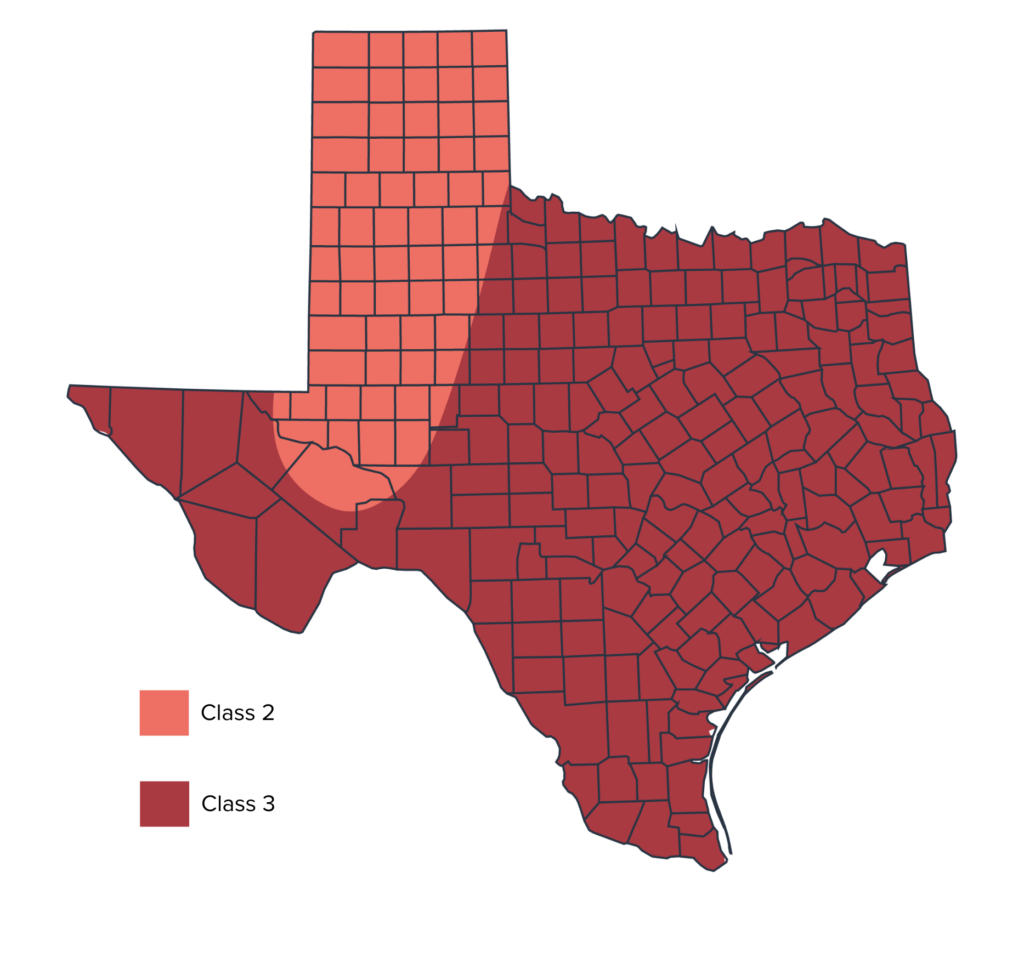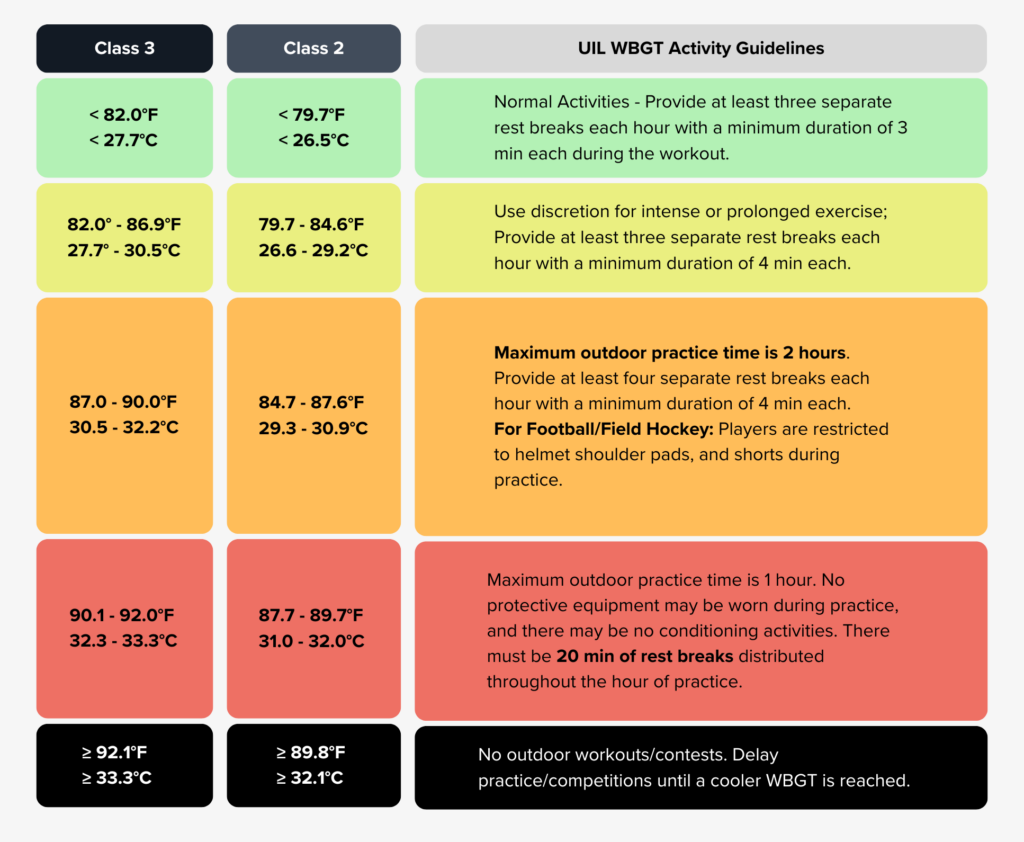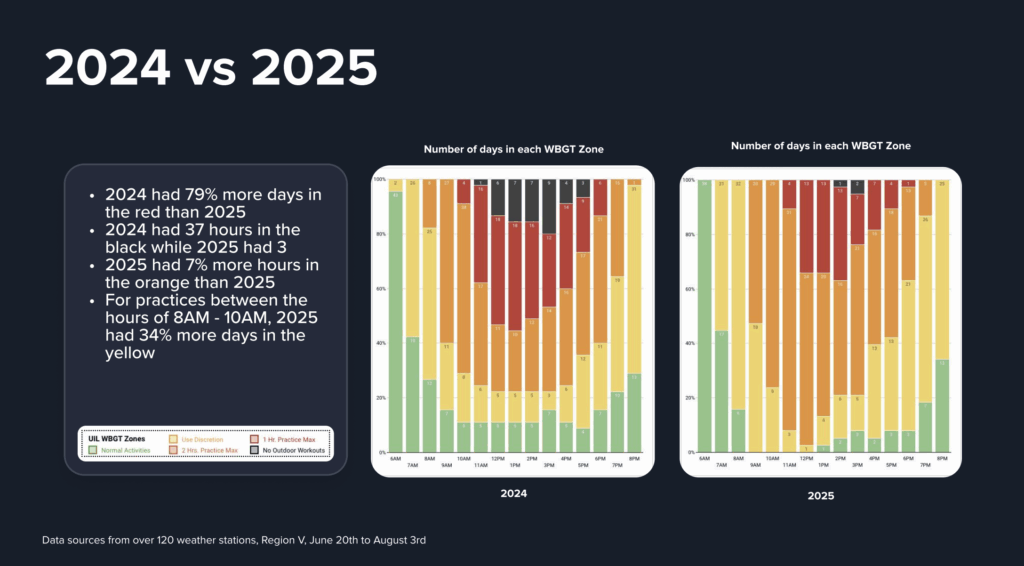Getting Ahead of the Heat: Your 2025 UIL WBGT Preseason Playbook
As preseason practice kicks off across Texas, athletic trainers are facing rising temperatures—and rising pressure. The University Interscholastic League’s (UIL) wet bulb globe temperature (WBGT) policy is entering its second year of implementation, and while many schools have adjusted, others are still working to find their rhythm.
To provide practical guidance, we hosted a webinar with Perry Weather’s CEO and founder, Colin Perry, who was joined by Cody Jenschke, the Head Athletic Trainer at Flower Mound High School and a seasoned SWATA leader with two decades of on-the-ground experience.
Together, they covered everything from the Texas UIL policy differences to planning safe, high-quality practices during the most brutal weeks of August. This session offers critical strategies to help you save time, stay compliant, and keep your athletes safe.
Watch the full session or keep reading for highlights and answers to the most common questions from Texas schools.
What This Webinar Covers
This year’s UIL heat policy guidance has made it clear: reactive decision-making isn’t enough. You need a proactive system that puts athlete safety first—without disrupting practice quality or creating chaos. In this session, Colin and Cody cover:
- How to interpret UIL WBGT policy zones (Green to Black)
- The difference between Class 2 and Class 3 policies
- How to prepare for preseason heat with acclimatization strategies
- What athletic trainers can do to reduce risk while maximizing quality practice time
- The challenges of manual WBGT tracking—and how to automate it
- Key data insights comparing 2024 vs. 2025 summers in Texas


Key Takeaways from the Webinar
1. Acclimatization Isn’t Optional — It’s a Safety Necessity
- Cody stresses that preseason heat acclimatization is about more than following UIL rules — it’s about protecting athletes from a shock to their system.
- Many athletes come into August from weeks of “AC relaxation,” and minimal outdoor activity.
- UIL’s mandated first-four-days progression — helmets only, then helmets + shoulder pads, then full pads — allows for a slow ramp-up to both heat exposure and physical contact.
- Athletic trainers should flag athletes who haven’t been outdoors or conditioning over the summer and work with coaches to keep them in green or yellow WBGT zones early on, only moving to orange or red when they’ve built tolerance.
- “Quantity” practices (long but low quality) can be counterproductive in high heat. Cody urges focusing on quality over quantity — a few good reps in safe conditions beat 100 bad reps in dangerous ones.
2. Pre-Practice Prep and Continuous Monitoring
- UIL recommends setting up the WBGT device 30 minutes before practice and taking an official reading 15 minutes before practice begins.
- One person — usually the athletic trainer or, in smaller schools, a coach — should be responsible for measurements.
- Measurements must be taken every 30 minutes during practice, with zone changes triggering required modifications:
- Crossing into red: helmets and shoulder pads come off, practice limited to one hour.
- Cooling zones should always be available.
- Cody’s approach:
- He checks WBGT all day long, not just pre-practice, and consults Perry Weather meteorologists the day before to plan.
- For afternoon practices (3–6 PM), he plans for the likelihood of moving from orange to red mid-practice.
- Before practice starts, he meets with coaches to decide what must be done in full pads and schedules those segments while the zone still allows it.
- In rare cases where WBGT starts in red, Cody says most coaches won’t run a full football practice without pads — so adjustments have to be made to get the most valuable work done.
3. Balancing Compliance with Real-World Logistics
- Changing practice times isn’t just about the team — it affects hundreds of families.
- At Wimberley ISD, moving to morning practices is a decision made for the entire week and communicated over the weekend.
- Cody highlights the importance of solutions-based communication:
- Don’t just tell the coach, “We have a problem.”
- Bring a clear plan: “We’re likely to hit red by 5 PM. Let’s get all padded drills done by 4 PM, then switch to non-padded work.”
- A strong trainer–coach relationship makes tough calls easier.
- “My job is lighter when we’re winning,” Cody says, underscoring that both safety and performance are aligned goals.
Cody Jenschke’s Tips for Managing Heat Stress
As Cody puts it: “All of this change has got one thing in mind — keeping kids safe.”
- Keep it accessible: Cody saves the UIL heat zone chart on his phone for quick reference.
- Plan ahead: Set expectations and schedules before the week begins. Communicate with coaches and parents early.
- Prioritize reps that matter: A short, efficient practice beats a long, unsafe one.
- Use the right metrics: Temperature alone isn’t enough. WBGT reflects humidity, solar load, and more.
- Be vocal: As the athletic trainer, it’s your job to advocate for safety and back it up with data.
“I tell my coaches: plan for the red zone. When it changes mid-practice, you won’t get that time back.” — Cody Jenschke
UIL WBGT Policy Rules to Follow
- Set up your WBGT device 30 minutes before practice, and take your first measurement at least 15 minutes before practice starts.
- Assign one person to handle WBGT readings to ensure consistency and accuracy.
- Take new WBGT readings every 30 minutes throughout practice.
- If WBGT levels move into a new zone, you must implement the appropriate modifications immediately.
- Maintain records of all WBGT readings taken during practices for future reference or audits.
- At 79.7°F WBGT or above, schools must have a rapid cooling zone ready that allows for full-body immersion in cold water (cold tubs).
“You can’t scramble when someone’s overheated—you need the setup ready before it happens,” Cody stressed. “Having a cooling area is non-negotiable at those WBGT levels.”
What the UIL WBGT Data Reveals

The UIL WBGT data painted a clear picture: heat risk in Texas is both extreme and unpredictable, changing sharply year-to-year and by region.
Key takeaways from the numbers:
- 2024 was historically hot.
- 79% more red-zone days than 2025.
- 37 average hours in the black WBGT zone, compared to just 3 in 2025.
- 2025 was milder—but not risk-free.
- Morning practices (8–10 a.m.) had 34% more yellow-zone days than in 2024.
- Even without red or black readings, these conditions still required modifications.
- Time of day matters.
- In 2024, 2–4 p.m. practices spent nearly 50% of days in red or black, severely limiting activity.
- 2025 afternoons were less extreme but still required close monitoring.
- Regional differences are significant.
- Class 3 regions (e.g., Dallas) recorded:
- 15 more hours in red
- 140 more hours in orange
- Compared to Class 2 regions (e.g., Houston).
- Hotter, more humid regions face greater and longer-lasting heat stress—something UIL thresholds account for.
- Class 3 regions (e.g., Dallas) recorded:
Bottom line: WBGT can change drastically from one summer to the next. A schedule that’s safe one year might be dangerous the next. Athletic trainers should:
- Use data to clearly explain restrictions to coaches and administrators.
- Monitor both live and historical WBGT data.
- Adjust schedules weekly, not just seasonally.
FAQs from the Webinar
What happens if I’m using Perry Weather but travel to a school or district that doesn’t have it or any WBGT sensors on site?
Perry Weather’s platform automatically connects you to the nearest available station in our network—what’s called a mesonet (a network of weather stations).
In Texas, we have over 500–600 stations equipped with full globe WBGT sensors spread across schools, cities, parks, private companies, golf courses, and other partners. When you travel, your device uses GPS to locate the closest Perry Weather station—often within a mile, even if your host school doesn’t have one installed.
This data updates every five minutes and comes from stations equipped with the proper instrumentation for accurate WBGT readings. Because Perry Weather is headquartered in Dallas and has deep roots in Texas, there’s a high likelihood that if you’re traveling anywhere in the state, you’ll have access to a nearby Perry Weather station for reliable readings.
Why does UIL have two different WBGT policy classes (Class 2 and Class 3), and why is Class 2 more restrictive?
The UIL divides WBGT zones—green, yellow, orange, red, and black—into three classes based largely on geography and athlete acclimatization.
Texas is vast, and conditions vary greatly from region to region. Most of the state falls into Class 3, which allows slightly more leeway in heat and humidity restrictions because athletes in these areas are generally more acclimated to hot, humid conditions. They’ve grown up in it, spend more time outdoors, and their bodies are better adapted to handle heat stress.
In contrast, Class 2 (and Class 1 in other states) applies to regions where athletes aren’t as accustomed to extreme heat and humidity. Their bodies may not handle heat stress as well, so the guidelines are more restrictive to ensure safety.
While this could easily turn into a geography lesson—covering differences in terrain, atmosphere, and climate—the bottom line is that UIL policy takes into account both the environmental conditions of the region and how well athletes are adapted to them.
What should athletic trainers and coaches look for when moving through the UIL WBGT zones, and how should they adjust practices?
UIL WBGT zones—green, yellow, orange, red, and black—each come with specific activity guidelines and required modifications. These are especially relevant for football because of the added heat burden from equipment, but they apply to all outdoor sports.
Here’s how to approach them:
-
Green Zone – Normal activity levels, but students should still receive regular rest and hydration breaks.
-
Yellow Zone – Continue full activity but monitor closely. Provide frequent water breaks and watch for signs of heat stress. Coaches should avoid outdated practices like withholding water.
-
Orange Zone (Class 3: ~87–90°F WBGT) – Practices limited to 2 hours, helmets and shoulder pads only (“half shell”), and 4-minute breaks at regular intervals. Breaks mean a complete pause—no drills or activity.
-
Red Zone (Class 3: ~90.1–92°F WBGT) – Practices limited to 1 hour, with 20 minutes of complete rest (no equipment, no activity).
-
Black Zone (92.1°F WBGT and above) – All outdoor activities are stopped. Treat this like a lightning delay—it’s a life-threatening condition.
Key tips:
-
Don’t rely on memory—keep a quick-reference chart on your phone.
-
Follow the UIL policy exactly; it’s designed to remove guesswork.
-
Remember that the “break” times are non-negotiable and must be true rest periods.
Why is it important to monitor WBGT closely at the start of football season, and how should athletes be acclimated to the heat?
The start of football season is one of the highest-risk times for heat-related illness. Many athletes come into preseason from a summer of air-conditioned downtime, less-than-ideal diets, and minimal outdoor activity. Jumping straight into high-intensity workouts in extreme heat can be a shock to the system.
Here’s how athletic trainers can approach it:
-
Start slow. The UIL mandates an acclimation period:
-
Days 1–2: Helmets only.
-
Days 3–4: Helmets, shoulder pads, and shorts (“half shell”).
-
Day 5 onward: Full pads.
This gradual increase helps athletes adjust both to the heat and the physical demands of practice.
-
-
Adjust for prior exposure. Athletes who haven’t been outdoors much need extra care. Consider keeping early practices in green or yellow WBGT zones for the first several days, even if later in the season you’ll face orange or red conditions.
-
Plan for game conditions. UIL WBGT zones apply to practices, but game-day recommendations differ—heat is monitored, not restricted. Exposing athletes to some controlled heat stress during practice helps prepare them for the hotter conditions they may encounter in a game.
-
Modify schedules when needed. If possible, hold practices in the morning or cooler parts of the day to reduce continuous high-heat exposure. Avoid stacking multiple orange or red days early in the season.
-
Prioritize quality over quantity. A shorter, focused practice with a few excellent reps is more valuable than a longer session filled with fatigued, sloppy reps—especially in the heat.
How should UIL WBGT readings be recorded and acted on during practices, and how can athletic trainers manage these requirements?
From an athletic trainer’s perspective:
Managing WBGT is a constant, all-day process — starting with checking forecasts the day before, coordinating with coaches, and planning padded drills early if conditions may worsen. Afternoon practices are more likely to shift zones, so flexibility is key. Continuous monitoring during practice ensures quick adjustments when thresholds are crossed.
Success depends on communication: bringing coaches solutions (not just problems), adjusting schedules for athlete safety, and keeping all stakeholders informed while still aiming for quality, productive practices.<!– wp:quote –>
<blockquote class=”wp-block-quote”><!– wp:paragraph –>
<p>As Cody puts it: “All of this change has got one thing in mind — keeping kids safe.”</p>
<!– /wp:paragraph –></blockquote>
<!– /wp:quote –>
What challenges do athletic trainers face with handheld WBGT sensors, and how does Perry Weather’s system help?
Handheld WBGT devices require significant manual work:
-
They must acclimate for at least 30 minutes before providing accurate readings, which means setting them up well in advance.
-
Athletic trainers have to take and log readings every 30 minutes, track zone changes, and communicate adjustments to multiple teams and coaches.
-
Smaller, non-standard black globes on some handhelds heat and cool faster than the human body, leading to less accurate results.
-
Communication is a constant challenge, especially for trainers managing hundreds of athletes across multiple facilities.
Perry Weather’s on-site WBGT stations automate nearly all of this:
-
Devices stay outside 24/7, eliminating acclimation delays.
-
Continuous monitoring and automatic logging remove the need for manual checks.
-
The platform applies UIL thresholds for your region and sends instant, custom alerts with clear instructions—e.g., “In red: remove pads, limit practice to 1 hour.”
-
Push notifications go out district-wide to all designated staff, reducing the burden on trainers to relay urgent updates.
For large schools, this means faster, more accurate decisions, less time spent chasing readings, and reliable communication—allowing athletic trainers to focus on athlete care instead of data gathering and message delivery.
Should schools use multiple WBGT devices for different fields or one central unit?
Cody Jenschke recommends one central WBGT station per campus—at least for compact facilities like Flower Mound High School. Treating the entire campus as one “global unit” keeps rules consistent and avoids confusion, especially among coaches.
With multiple devices, you risk conflicting readings—e.g., baseball in orange while football is in red—which creates communication headaches and potential disputes (“Why can they practice but we can’t?”). A single station simplifies policy enforcement, ensures fairness, and makes it clear to all coaches and athletes what’s allowed.
From a feasibility standpoint, monitoring multiple practice areas would mean:
-
Buying and maintaining multiple WBGT devices
-
Assigning staff to each unit
-
Repeating all the UIL compliance steps for each location
This is impractical for most schools. The goal is to measure conditions holistically, keep athletes safe, and run the longest, most productive practices possible under the same environmental guidelines.
An exception: if a school has widely separated facilities—like a football stadium far from other fields—and dedicated staff at each location, multiple stations can make sense. But for most campuses, one global unit keeps things simple, consistent, and easier to manage.
Thanks for joining us. We hope the webinar gave you practical takeaways for managing heat stress and keeping athletes safe. Perry Weather removes the guesswork from weather safety decisions—try it yourself with a free two-week trial.









